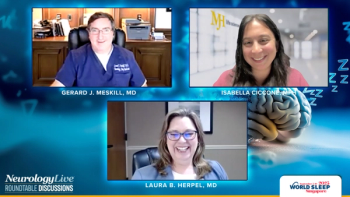
Aducanumab’s Approval for the Treatment of AD
Jeffrey L. Cummings, MD, ScD, discusses the importance of aducanumab, a recently approved treatment for Alzheimer’s disease.
Jeffrey L. Cummings, MD, ScD: The newest approved treatment for Alzheimer’s disease is aducanumab [Aduhelm]. This is the first drug to be approved by the FDA for the treatment of Alzheimer’s disease since 2003. It’s also the first drug that modifies the underlying pathophysiology of Alzheimer’s disease, and would therefore be seen as a disease-modifying therapy. Aducanumab is a monoclonal antibody that is infused into the patient on a monthly basis. That monoclonal antibody enters the brain and can have 2 effects. One is to interfere with the aggregation of amyloid species—we know that the aggregated species is more toxic—and it also activates microglia. The microglia then are the resident cells in the brain that will remove the amyloid when activated. When we do an amyloid scan after treatment with aducanumab after about 6 or 12 months, we can see that the amyloid plaque is being systematically reduced.
Aducanumab is 1 of only 4 monoclonal antibodies that are currently in study. Aducanumab is the only approved monoclonal antibody, but donanemab is also being studied, lecanemab is in clinical trials, and gantenerumab is the fourth monoclonal antibody that’s in clinical trials. Each of these has different delivery mechanisms, slightly different chemical mechanisms, and slightly different targets. We don’t really understand whether they’ll be different from a patient perspective, except for the delivery mechanisms.
Because all of these drugs remove amyloid from the brain but also remove amyloid from the blood vessels of the brain, they allow leakage of fluid out of the blood vessel into the brain and occasionally allow a microhemorrhage to occur. That’s called ARIA [amyloid-related imaging abnormalities]. Most of these—80%—are asymptomatic, and most that are symptomatic are relatively minor, but occasionally they can be very severe.
We’re very careful in monitoring for ARIA in our patients. We get a scan at baseline. We get a scan before we go to the 6 mg/kg dose, before we go to the 10 mg/kg dose, and after patients have been at the 10 mg/kg dose for 6 months. We stop therapy if we see ARIA and watch the ARIA-E—the fusion type of ARIA—resolve, or watch the ARIA-H—the hemorrhage type of ARIA—become stable. It’s very important that this type of safety monitoring be done. We hope that in the future, we’ll have either monoclonal antibodies or other treatments of amyloidosis that have fewer complications and fewer requirements for vigilance for patient safety.
The appropriate patient for aducanumab therapy has early Alzheimer’s disease. They have mild cognitive impairment [MCI] or early Alzheimer’s disease dementia. They would have a Mini-Mental State Examination score of 20 or above. They’re very mildly affected. In the clinical trials, there were complications because it was thought early on that the drug wasn’t working, and the trials were declared to be futile. But as they continued to gather the data in a blinded fashion, it was clear that 1 of the trials was positive and 1 of the trials was negative. When a positive trial is identified, it’s because it has slowed the rate of decline of the patient’s cognition. That’s so important because that’s what we’re trying to achieve in early treatment: a slowing of decline of cognition, a slowing of decline in function, and a reduced emergence of the neuropsychiatric features of Alzheimer’s disease. All of those were observed in 1 of the 2 studies.
Why was 1 study negative and 1 study positive? At least 1 potential explanation is that patients in the positive study were at the higher dose for a longer period of time, and patients in the negative study weren’t at the higher dose for as long. We believe that may in part account for the differences between the 2 studies. But there’s substantial evidence from an earlier study called PRIME as well as the 2 studies that were declared to be futile and then found to be positive that show that the drug is working to reduce the rate of cognitive decline.
How would we think about this? Let’s say that MCI is a period that in general is 5 years long, from the mildest MCI to the time when the patient enters the dementia stage of Alzheimer’s disease. With a 20% slowing, which was shown in the analysis of the EMERGE trial of aducanumab, one would have 1 additional year of life before they entered the dementia phase of Alzheimer’s disease. That’s very important to people’s quality of life. They have more time with their friends. They have more time with their own self-identity. They have time to travel. These are the important things of the later types, the later years of life that are remaining for this individual patient. Slowing of decline is clinically meaningful.
In deciding whether a patient should be treated with aducanumab, you first have to be sure that the diagnosis is MCI due to Alzheimer’s disease or early dementia due to Alzheimer’s disease. That would be done with a careful neurological and mental status examination. If the patient looked like they had Alzheimer’s disease, they would then have the diagnosis confirmed with amyloid imaging or CSF [cerebrospinal fluid] studies of amyloid.
There are some patients who shouldn’t be treated with aducanumab. Those who have too much vascular pathology at baseline on MRI shouldn’t be treated with aducanumab because they might then have more microhemorrhages. Similarly, patients who are on blood thinning agents or anticoagulants shouldn’t be treated with aducanumab because you might be more likely to have microhemorrhages in the face of the thinning of the blood. Finally, patients who can’t have an MRI shouldn’t be treated with aducanumab because the MRI is critical for both establishing the baseline appropriateness of the patient and for monitoring ARIA over time. A patient who has a pacemaker or other metal in their body that forbids the use of MRI shouldn’t be treated with aducanumab.
This transcript has been edited for clarity.
Newsletter
Keep your finger on the pulse of neurology—subscribe to NeurologyLive for expert interviews, new data, and breakthrough treatment updates.





































